|
Pivotal World Series Plays
Brecheen Saves the Cards
1946 World Series - Game 7: Boston Red Sox @ St. Louis Cardinals
Southpaw Harry "The Cat" Brecheen had won 15 and lost 15 for St. Louis during the '46 season, his fourth with the Cardinals. While his record was just 15-15, Harry sported a sparkling 2.49 ERA, a hint that his teammates often let him down at the plate. He hurled five shutouts.
Brecheen outdid himself during the World Series. After Boston won the opener 3-2, Harry shut out the potent Red Sox lineup 3-0 in Game 2. With Boston leading three games-to-two, he came through again in the must-win sixth game 4-1.
The southpaw from Broken Bow OK was listed as 5'10" 160 lb, but the Red Sox swore he weighed 150 or less. Brecheen's best pitch was his screwball, followed by his curve. He used his middling fastball as a waste pitch to keep hitters off balance. He was the epitome of the "crafty left hander."
Harry had great success against Ted Williams, keeping him off balance with breaking balls down and away and pitches up and in. In nine at-bats in Games 2 and 6, Ted was limited to a walk and what he called "one chicken-shit single." In his nationwide syndicated column during the Series, the Boston star described The Cat's twirling like this: "Brecheen's pitches look nice to hit at, but when you try to hit him, the ball just isn't where you think it's going to be." Ted made the point that the pitcher always has the advantage over a hitter who hasn't seen him regularly. That was especially true of an unconventional hurler like The Cat.
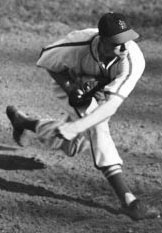 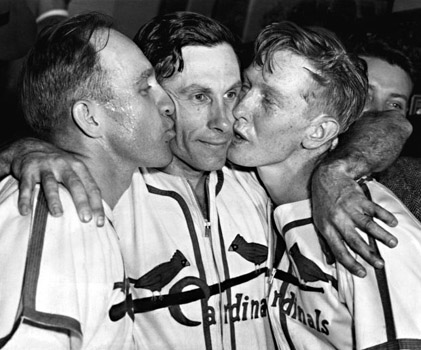 L: Harry Brecheen pitches in Game 2. R: Enos Slaughter (L) and Red Schoendienst kiss Harry after Game 6. With wartime travel restrictions ended, the Series returned to its traditional 2-3-2 format, starting in St. Louis. The teams played six straight days with a pre-planned day off after Game 6 if a seventh game was needed.
The hiatus allowed Dyer to envision using Brecheen in relief if necessary in Game 7. But a monkey wrench was thrown into that plan when Harry showed up for the final game feeling terrible. He traced his illness to the aftermath of Game 6. By the time he got to shower after talking to reporters, all the hot water in the outdated clubhouse was gone. He figured the chilly shower weakened his immune system. "I had a fever and a cold and my head was about to bust open," he explained after Game 7. He "filled up on aspirin," bundled up despite the warm weather, and huddled in the dugout not expecting to see any action.
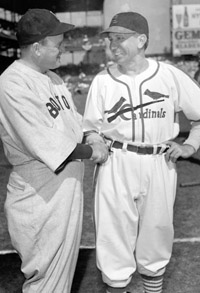 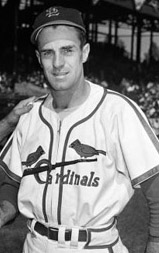 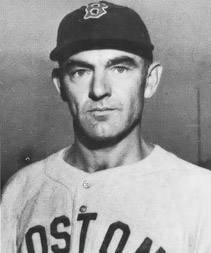 L-R: Joe Cronin and Eddie Dyer, Murry Dickson, Wally Moses Murry Dickson started Game 7 for the Redbirds and pitched well through seven innings, limiting the Sox to three hits and one run. Thinking ahead, Dyer walked over to where Brecheen shivered miserably in the corner of the dugout and asked him how he felt. "My arm feels okay, at least," the Cat replied. So Harry headed to the bullpen to get ready in case he was needed.
Needing to inject some life into his team with time running out, Boston manager Joe Cronin turned to his bench. First, he sent up Glenn "Rip" Russell to hit for C Hal Wagner, a .208 right-handed hitter in place of a .230 lefty who was 0-for-13 in the Series. But the hunch worked as Rip lined a curveball into center field for a single, the first hit off Dickson since the second inning.
Joe's next decision was a no-brainer. George "Catfish" Metkovich hit for P Joe Dobson. The left-handed batter sent a screaming double down the left field line. Cronin, coaching third base, stopped Russell there.
With another lefty, RF Wally Moses, due up, Dyer came out and called for Brecheen.
Dickson angrily went to the locker room, showered, and left the park. He drove around listening to the game on the radio.
The switch started well, as Wally whiffed on three pitches. He protested the call on the final curveball, claiming it was low. Then RF Enos Slaughter came in fast to catch SS Johnny Pesky's low liner and hold the runners on their "respectable bases," as Dizzy Dean would say. One more out and The Cat would add to his two complete game victories a sparkling save and bring back memories of Grover Cleveland Alexander's relief stint against the Yankees in Game 7 of the 1926 Series.
Old Alex was in attendance at the game.
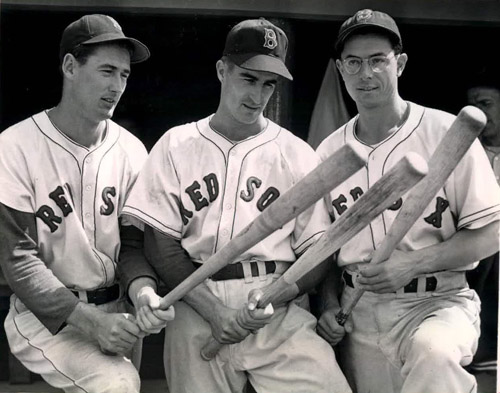 L-R: Ted Williams, Johnny Pesky, Dom DiMaggio But if Harry was a thinking man's pitcher, the next batter, CF Dom DiMaggio, was a thinking man's hitter. That's why they called him the "Little Professor." Years later, he could remember every pitch of the at-bat and what he was thinking.
Brecheen started with a high fastball that home plate umpire Al Barlick called a strike, to Dom's surprise. When he protested, the ump told him to get in there and hit. Next came a curve inside to make the count 1-1. Harry tried two screwballs in a row, both down and away. Dom bit on neither to make it 3-1.
He stepped out and looked to Cronin for a sign. Told to hit away, the professor considered the possibilities. He ruled out a fastball, The Cat's weakest pitch. Also, the lefty hadn't been getting his curve over that day. And he didn't want to walk Dom with Williams up next. So it would be another screwball but not inside where the hitter could pull it. Only one possibility remained - the same outside screwball as the last two pitches but in the strike zone. Brecheen would want Dom would try to pull it and hit a weak grounder. So DiMag resolved to go with the pitch. Sure enough, Brecheen threw a screwball that "was just a bit too high" (to use Harry's description), and Dom smashed it off the wall at the 354' mark in right-center field, missing a home run by two feet. Thinking triple, Dom ran as hard as he could around first until he felt a hamstring pop. He hobbled into second base with a double as the tying runs scored. The only noise in the stadium came from the Red Sox dugout.
The good news for the Sox was they tied the score. The bad news was that Dom had to leave the game. Backup OF Leon Culberson ran for him. Cronin had no choice, but the move would have dire consequences.
After a 20-minute delay, the game resumed with Williams stepping in with a chance to drive in the go-ahead run and erase all the negative press he had received since falling into a slump in mid-September. (Ted had not homered since September 13.) He would go from Goat to Hero.
The Cardinals lost a player as a foul tip off Williams' bat split the third finger of C Joe Garagiola's right hand. Del Rice replaced Joe behind the dish, delaying the game a few more minutes, enough time for Ted to analyze the situation and decide Harry would go with his best pitch, the screwball. Instead, Brecheen jammed The Splinter with a fastball. The result was a towering popup close to the right field line that 2B Red Schoendienst caught to retire the side.
The Cards broke the tie in the bottom of the 8th on one of the most famous plays in World Series history: Enos Slaughter's scoring from first base on Harry Walker's double. Read about Slaughter's mad dash ...
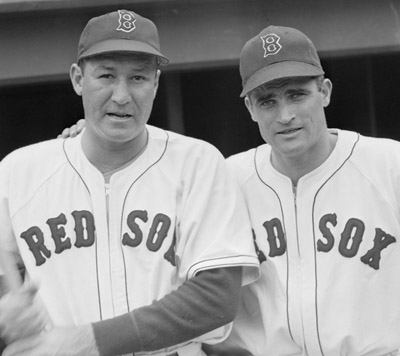 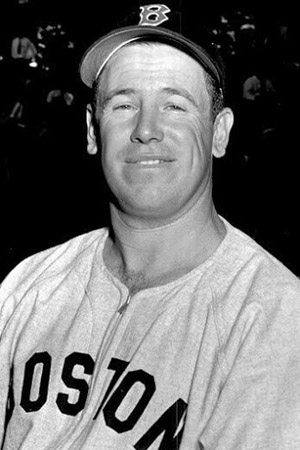 L-R: Rudy York, Bobby Doerr, Tom McBride Far be it from this exciting series to end quietly. Cardinal fans were confident with Brecheen on the mound, but they didn't know how sick he was.
1B Rudy York bounced a single past 3B Whitey Kurowski. Paul Campbell ran for Rudy. Hitting away, 2B Bobby Doerr dropped a single into short left field just past lunging SS Marty Marion. Campbell, the potential tying run, stopped at second.
The Cardinals gathered at the mound. Some looked to their dugout, but Dyer made no move. They discussed what to do if the Red Sox bunted and decided they'd try to get Doerr to keep the go-ahead from getting into scoring position.
Dyer said afterward: "When the first two Red Sox got hits off him in the ninth, I decided right then and there to let him stay in. He had gotten out of tight spots so many times this season that I sort of figured he might do it again. But if he failed this time, I was going right along with him even if we lost the game."
Following the rules of Baseball 101, 3B Pinky Higgins bunted down the third base line but too hard. Kurowski threw to Marion to force Doerr at second. Still, the tying run now stood only 90' from home with only one out.
But Brecheen got C Roy Partee to foul to 1B Stan Musial, who caught the ball after a long run and immediately fired home in case Campbell had any thought of trying to score.
So Red Sox hopes came down to Tom McBride, a backup outfielder who hit .301 in '46 and whose scratch single in the 9th inning tied Game 1. He hit what Brecheen called "a good screwball" on the ground to Schoendienst. The ball bad hopped enough to roll up Red's right arm, but he corralled it and tossed to Marion just in time for the force at second.
Brecheen: "The nicest pitch I think I made all season was the one I threw Tom McBride to end the game. It was a screwball, and it broke nicely so that Tom couldn't do much with it."
The final play had particular significance for Schoendienst, as he explained in his autobiography: "The Red Sox mounted a threat, putting two runners on with two outs. The next batter, pinch-hitter Tom McBride, hit a slow roller toward me that looked as if it would be an easy chance. Instead, just as I went to field the ball, it took a crazy hop and I blocked the ball with my left shoulder. Luckily I was able to trap it, and flipped the ball to Marion covering second for the final out. ... (His girlfriend) Mary was sitting in the stands, watching the game with her family. We had talked about getting married, but she still hadn't officially been granted her family's blessing. One of the people at the game was her grandfather, Patrick O'Reilly." Mary recalled, "He was still not sure about Red, until he made that play. After the ball hit him in the chest, then rolled up his arm, and he still made the play and we won the game, then my grandfather said, 'You can marry him now.' He had not been too happy about that 'German' I was going to marry." |